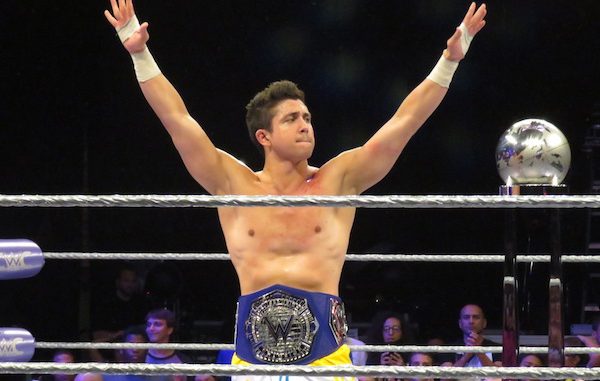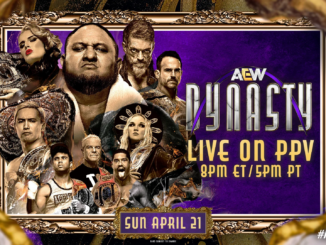
SPOTLIGHTED PODCAST ALERT (YOUR ARTICLE BEGINS A FEW INCHES DOWN)...
Why has the Cruiserweight Division flopped in WWE after just a few months? The following are five key reasons…
(1) DIVISIONS NEED STARS
The cruiserweight division has been a flop for many reasons. Too many even to cover in this piece. But one of the most significant reasons is because there’s no stars in the division. Wrestling is, was, and forever will be a star-driven business and will always be at its hottest when it’s being sold on star power rather than “a really good wrestling show.”
In order to see where the division failed, we need to take a step back and look at the division from the perspective of a viewer unfamiliar with all these debuting acts. Not the type of viewer reading this article who already knew that a Tony Nese was a wrestler and not part of a tool kit, but the type of viewer whose wrestling intake is exclusively Raw and Smackdown. The only name that they may be even vaguely familiar with is Brian Kendrick and, if they do, they’re familiar with him as an act from a previous era in WWE that never amounted to much of anything.
So you’re seeing all these acts for the first time. Where’s the wow factor? The division is full of supporting acts with no leading acts. Kota Ibushi. He would have been a leading act to headline the division and generate a buzz. Yes, he wouldn’t commit to signing a full time contract, but they could still find a way to bring him in twice a month as the champion that comes in to defend his crown and put the division on the map while you spend the in-between shows building up challengers to him. Other, probably more feasible, options include Neville or Kalisto or even waiting to debut the division for Gran Metalik’s arrival from Mexico.
Instead, the division has been headlined by Brian Kendrick, T.J. Perkins, Rich Swann, and Cedric Alexander – all great talents in their own right, but none of them are stars who grab your immediate attention and generate an instant buzz. And that leads into the next lesson…
(2) FIRST IMPRESSIONS ARE EVERYTHING
The first impression of the division was absolutely lousy and, within at most a few shows, it already had the stigma of a failed uninspired project. That perspective coming out of the Cruiserweight Classic when the same viewers were just beaming about the quality of the show and the prospect for a Cruiserweight Division on the main roster was a quite remarkable turnaround on WWE’s part.
The lesson from that is don’t rush into things. They decided to debut the cruiserweights the first possible chance they had after the Cruiserweight Classic to cash in on the buzz it had generated, a smart move on paper, but one completely negated by the fact the infrastructure wasn’t in place for the division to succeed. Instead, they debuted with no star power and a lack of memorable matches/promos/rivalries/anything.
The template for all of this should have been Ring of Honor’s first Supercard of Honor in 2006. At the time Dragon Gate was a niche of an already nice puroresu product to North American wrestling fans. Gabe Sapolsky brought them into ROH for the first time as relative unknowns during 2006’s trio of WrestleMania weekend shows, another lasting legacy that this famous weekend had on the independent scene. Yet by the end of that weekend they were as over as any act on ROH’s trio of shows that weekend. The trios match on the Supercard of Honor show wasn’t the only match that weekend involving Dragon Gate talent, but it was the statement-maker that cemented the reputation of any Dragon Gate talent to come over stateside that still stands a decade later. It was a match which, in 20 minutes without prior introduction of the characters or the stories involved, gave the Dragon Gate trios match an air of MOTY expectancy every year.
WWE would have been wise to learn from that match. Choose some of the best cruiserweight wrestlers you have available and just let them go out in their debut showing. Tell them the shackles are off and do whatever you need to have the most incredible spectacle possible. If that means using Kota Ibushi, who may only be used a special attraction talent in the division, then so be it. Send him out there with Gran Metalik, make Metalik in an instant superstar, and let them have a match that will give the division a reputation to live off for years to come.
When the division debuted, it should have made a big impact. Shout out a message to a new audience that the cruiserweights are something you won’t see anywhere else on the card and are must see. What we got instead was a division full of midcarders for life having tepid matches as part of uninspired storylines.
(3) DIFFERENTIATION IS KEY
Why should I care about the cruiserweights? There’s no star power in the division, so they need some sort of appeal. I have no idea what the selling point of the Cruiserweight Division is supposed to be (outside of selling Hunter’s image as the messiah of the hardcore fans). So you’re not watching the cruiserweights for any sort of star power or captivating characters. They don’t wrestle a more exciting style than the one present throughout the rest of the card. It’s actually a more toned down town style in the cruiserweight matches with more rest holds to lose an already disinterested crowd with. They definitely aren’t having better matches than the ones outside the division. There’s really no reason to care about the cruiserweights when they’re just a weaker extension of what viewers could already see for at least five hours every week. But hey ho, they have purple ropes.
It doesn’t help one bit that the bigger wrestlers outside the division all do high flying moves that used to set the cruiserweights in WCW apart from everyone else on the card. But they aren’t setting a bar for high flying (A.J. Styles being the exception) that can’t be raised by the cruiserweight competitors. The likes of Ricochet, Will Ospreay, and Dragon Lee pull off feats of athleticism that are beyond belief and completely unique to the high flying featured in a Cesaro vs. Sami Zayn match, for instance. And while they may be the peak of what high flyers are capable of, high flyers that can differentiate the wrestling style of the Cruiserweight Division from everyone else on a WWE show aren’t overly hard to find. Even within their own company, letting the likes of Gran Metalik, Lince Dorado, Neville, and Kallisto raise the standard for high flying would help to offset this problem.
It doesn’t have to be differentiating the division by increasing the stakes for dangerous high flying maneuvres. The cruiserweights being the only place to see a submission-centred mat-based style would also work. Or making all the matches two-out-of-three falls. Or all 10 minute time limit matches. Or steal the old FCW 15 concept. Or literally anything to separate them from the rest of the roster because the belief that having them work a more restrained version of the style present throughout the rest of the card would get them over was a mistake that at least they can learn from but should have never been made in the first place.
(4) DEBUTING TOO MANY NEW ACTS ALL AT ONCE IS A BAD IDEA
With the Cruiserweight Division, WWE gave themselves the unenviable task of introducing literally an entire division of new acts to a new audience all at once. When debuting just one new act, it can take time to introduce them and get them over with your audience. The only act with any sort of name recognition to the majority of WWE’s audience is Brian Kendrick and even he is being re-introduced with a new personality to get over. The rest of the names aren’t even big names on the independent scene. Only your most hardcore of hardcore fans have been following the careers of names like Rich Swann and Drew Gulak.
Some acts have the advantage of being able to get over in an instant. Rey Mysterio’s in-ring style had you instantly hooked. The Rock’s promos had you instantly hooked. Shinsuke Nakamura’s unique charisma has you instantly hooked. But these are all special talents. None of the cruiserweights have personalities or wrestling styles anywhere close to falling into that category.
If you have some already established acts to transfer into a new division, then you give new acts a better chance of getting over because fans are already familiar with at least some foundations of a new entity and it helps the newness become a little less overwhelming. From that very first four-way match on Raw, all these new acts debuted to no reaction, which is fine for a debuting act. Nobody knows them, so that’s to be expected. But it becomes a problem when the other half is also in the same boat. Then the audience isn’t familiar with anything in front of them, and that’s a problem because you then create the perception that none of these acts are in the slightest bit over and who cares about acts like that?
If you’re new to something and you see that this new thing has a buzz about it, you’re instantly more into this new thing because others are too. If the new thing has no buzz at all, then the viewer reaction also flips with it. Attention garners attention. There’s a reason why WWE typically don’t follow this formula when introducing a new wrestler.
(5) A NEW TITLE IS LIKE A NEW WRESTLER
When you debut a new wrestler, it takes time to establish them, and in order to establish them as a top act that can become a draw, you have to book the wrestler well. The exact same is true for titles. Winning a championship should be an accomplishment and a tool to help put a wrestler over. But titles can only do that if you put the title itself over first.
To use Ring of Honor as a case study again, go back to Samoa Joe’s title reign. Prior to that, the ROH Title was a title which meant something but not a massive amount. Joe’s title reign put ROH and the belt on the map and made winning the ROH Title not only something that mattered, but certified a wrestler by winning it. To use another more recent example, look at how Shinsuke Nakamura made the Intercontinental Championship in New Japan. New Japan booked the title to put it over and, as a result, can cash in on the equity built up in the belt and transfer that to whoever holds it. Now when a Bad Luck Fale-level wrestler wins the belt, the act moves up to the level of the title rather than the title moving down to the level of the act.
WWE has failed to do that with the Cruiserweight Championship and, as a result, Rich Swann beating Brian Kendrick for the belt was barely even a talking point. WWE needs a title reign that puts the title on the map and invests some equity in the belt that can then be transferred to whoever is holding it. Because without creating that equity, the belt is just a prop and winning a prop isn’t a big deal.
NOW CHECK OUT LAST WEEK’S ARTICLE: FIVE COUNT: Five lessons WWE can learn from TLC including a Smackdown’s lack of acts that are actually over, comedy quotient




Great column. Also, choosing TJ Perkins as your first champion was an awful idea; he wasn’t ready for that role. The title has already had 3 title changes since its inception.
I’ll go one better than that 6-Man: June 26, 2002. The Double Elimination 4-Corners Match to determine the 1st ever NWA World X-Division Champion. AJ Styles -vs- Jerry Lynn -vs- Psicosis -vs- Low-Ki. A new concept, a new championship, & four men who gave it everything they had, as if it was the most important match of there careers. It established the tone of the division, put AJ Styles & Low-Ki on the map, resurrected the career of Jerry Lynn, & gave a decent national ride off for Psicosis. 14 years later, it’s still one of the most hotly contested & meaningful championships in wrestling. This current division in WWE fighting over the Men’s Women’s Title is bring up flashbacks of WWE’s failed Light-Heavyweight Division from 19 years ago. Although, the Men’s Women’s Title has already been defended more in the 3 month’s of its resurrected life than the combined 793 days amassed by Taka Michinoku, Christian & Duane Gill, so there is that positive. Honestly, an option for the division at this point should be to move it to NXT, give that show another 30 minutes, & let those rosters battle for it in a setting where the crowd can at least pretend that the match is for something meaningful. And it would give non-NXT Title contenders something to go after. Just my thoughts.